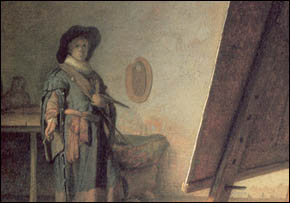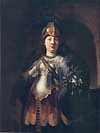Complete Rembrandt Catalogue: History Paintings I

When complete, this online catalogue will comprise more than 300 paintings divided into 7 sections: history paintings, landscapes and animals, self portraits, portraits of family members, genre scenes and portraits.
This catalogue does not propose any single evaluation, however authoritative, by any single party as to the authenticity of any painting. Rather, it should be considered an overview, or a distillation of those works which seem for the most part generally accepted as authentic works painted by the artist's hand. In fact, it has proved particularly vexing to establish a definitive catalogue of Rembrandt's oeuvre. Many works are poorly preserved and have been overpainted by later hands and number of very important attributions are still disputed.
The situation is also complicated by the fact that Rembrandt took on an unusually high number of apprentices in order to insure him a significant income. Some of these apprentices were sufficiently talented as to emulate Rembrandt's own painting and their best works are arduous to distinguish from Rembrandt's own. His work was also imitated by other talented painters as well both during and after Rembrandt's lifetime.
Every effort is being made to acquire the best quality high resolution images, which, however, is not possible in all cases.
What is a History Painting?
A history painting is one which has a serious narrative, or includes exemplars of actions which are intended to have didactic overtones. In this sense the word history relates to the Italian istoria, meaning narrative or story (and not the accurate or documentary description of actual events). History paintings are often large in scale. Their subjects can be taken from the Bible, from mythology or other forms of secular literature, from historical events; or they can be allegories. Noble themes are seen as being particularly worthy of depiction.
History painting was viewed as the most important of the genres from about the 16th century, and the climax of an academic painter's training. It was the equivalent of Epic or Tragedy in literature.
In the Netherlands, history painting, which was once the pinnacle of pictorial art, gradually became a minority art. Most young painters opted for the specialist career in one of the categories of painting that were menaced by realism. This was also, of course, a result of the economic situation within which they had to find a living as professional painters.
 |
The Stoning of St.
Stephen (hi res image) 1625 oil on canvas 89.5 x 123.6 cm. Musée des Beaux Arts, Lione |
 |
History
Painting (hi res
image) (Palamede in Front of Agamennone?) 1626 oil on wood 90.1 x 121.3 cm. Stedelijk Museum De Lankenhal, Leiden |
 |
The Baptism of the
Eunuch (hi
res image) 1626 oil on wood 63.5 x 48 cm. Het Catharijne Convent, Utrecht |
 |
Tobit
and Anna with the Kid (hi res image) 1626 oil on wood 39.5 x 30 cm. Rijksmuseum, Amsterdam |
 |
Balaam and the Ass 1626 oil on wood 63.2 x 46.5 cm. Musée Cognacq-Jay, Paris |
 |
The Rich Man
from the Parable (hi res image) 1627 oil on canvas 31.9 x 42.5 cm. Staaliche Museen Preussischer, Kulturbesitz,Gemäldegalerie Berlin |
 |
St. Paul
in Prison 1627 oil on wood 72.8 x 60.2 cm. Staatsgalerie, Stuttgart |
 |
David Present the Head of
Goliath to King Saul ((hi
res image)) 1627 oil on wood 27.5 x 37.5 cm. Kunstmuseum, Basel |
 |
Samson and Dalila (hi
res image) 1628 oil on wood 59.5 x 49.5 cm. Staaliche Museen Preussischer Kulturbesitz, Gemäldegalerie Berlin |
 |
Two Old
Men Disputing (St. Peter and St. Paul) 1628 oil on wood 72.3 x 59.5 cm. National Gallery of Victoria, Melbourne |
 |
Presentation
in the Temple c. 1627-1628 oil on wood 55.4 x 43.7 cm. Hamburger Kunsthalle, Hamburg |
 |
Judas Repentent, Returning the Pieces of Silver (hi res
image) 1629 oil on wood 79 x 102.3 cm. Private Collection, England |
 |
St Paul at his Writing-Desk (hi res
image) 1629 oil on wood 47.2 x 38 cm. Germanisches Nationalmuseum, Nuremberg |
 |
The Supper at Emmaus c. 1629 oil on paper on wood 37.4 x 42.3 cm. Musée Jacquemart-André, Lione |
 |
David Playing the
Harp for Saul (hi
res image) c. 1629 oil on wood 61.8 x 50.2 cm. Stadelesches Kunstinstitut, Frankfurt |
 |
Andromeda c. 1629 oil on wood 34.1 x 25 cm. Mauritshuis, The Hague |
 |
Jeremiah Lamenting the Destruction of Jeruselem (hi
res image) 1630 oil on wood 58.3 x 46 cm. Rijksmuseum, Amsterdam |
 |
The Abduction of Proserpina c. 1630 oil on wood 83 x 78 cm. Staaliche Museen Preussischer, Kulturbesitz,Gemäldegalerie Berlin |
 |
Christ on the Cross 1631 oil on canvas on wood 99.9 x 72.6 cm. Parish Church, Le Mas d'Agenais, France |
 |
The
Apostle Paul in Prison 1631 59 x 47.8 cm. oil on wood Collection Joel Frieland, Florida |
 |
The
Presentation of Jesus in the Temple (hi
res image) 1631 oil on wood 25 5/8 x 18 7/8 in. Mauritshuis, The Hague |
 |
The Raising of Lazarus (hi
res image) c. 1631-1632 oil on wood 96.2 x 86.5 cm. Los Angeles County Museum of Art, Los Angeles |
 |
Minerva c. 1631-1632 oil on wood 60.5 x 49 cm. Staaliche Museen Preussischer, Kulturbesitz,Gemäldegalerie Berlin |
 |
The Apostle
Paul 1632 oil on canvas 81.3 x 66.2 cm. Nationalmuseum, Stockolm |
 |
The Rape of Europe 1632 oil on wood 62.2 x 77 cm. Paul Getty Museum, Los Angeles |
 |
A Heroine from the Old Testament c. 1632 oil on canvas 104.2 x 94.4 cm. National Gallery of Canada, Ottawa |
 |
The Descent from the
Cross c. 1632-1633 oil on canvas on wood 89.6 x 65 cm. Bayerische Staatsgemäldesammlungen,Alte Pinakothek Munich |
 |
Bellona (hi
res image) 1633 oil on canvas 127 x 97.5 cm. Metropolitan Museum of Art, New York |
 |
Daniel and King Cyrus in
front of the Idol of Bel 1633 oil on wood 23.4 x 30.1 cm. Paul Getty Museum, Los Angeles |
 |
Christ in the Storm 1633 oil on wood 160 x 127 cm. Isabella Stewart Gardner Museum, Boston |
 |
Joseph Tells his Dreams c. 1633 oil on paper 55.8 x 38.7 cm. Rijksmuseum, Amsterdam |
 |
The Raising of the
Cross c. 1633 oil on canvas 95.7 c 72.2 cm. Alte Pinakothec, Bayerische Syaatsgemäldesammlingen, Munich |
 |
The Entombment c. 1633-1635 oil on wood 32.1 x 40.3 Huntarian Art Gallery, Univesity of Gasglow, Glasgow |
 |
Ecce Homo 1634 oil on paper on canvas 54.5 x 44.5 cm. National Gallery, London |
 |
Christ Resurected 1634 oil on wood 53.1 x 50.5 cm. Museum Pushkin, Mosca |
 |
The Holy Family (hi
res image) 1634 oil on canvas 183 x 123 cm. Alte Pinakothec, Bayerische Syaatsgemäldesammlingen, Munich |
 |
Cupid Blowing
Soap Bubbles 1634 74.7 x 92.5 cm. oil on canvas Collection of the Baroness Bentick-Thyssen, Ascona (Switzerland) |
 |
Artemesia (also called 'Soponisba')
(hi
res image) 1634 oil on canvas 142 x 153 cm. Museo del Prado, Madrid |
 |
John the Baptist
Preaching 1634-1635 oil on canvas on wood 62.7 x 82.1 cm. Staaliche Museen zu Berlin, Berlin |
 |
Diana Bathing
with her Nymphs, with Stories of Acteon and Calisto c. 1634-1635 oil on wood 73.5 x 93.5 cm. Museum Wasserburg Anholt, Anholt (Germany) |
 |
Abrahams' Sacrifice (hi
res image) 1635 oil on canvas 193.5 x 132.8 cm. Hermitage Museum, Leningrad |
 |
The Rape of
Ganymede (hi
res image) 1635 oil on canvas 177 x 129 cm. Staatliche Kustsammlungen, Gemäldegalerie, Alte Meister, Dresden |
 |
Minerva 1635 oil on canvas 137 x 116 Bridgestone Museum of Art, Tokyo (from a private collection) |
 |
The Lamentation
over the Dead Christ c. 1635 oil on paper on canvas on wood 31.9 x 26.7 cm. National Gallery, London |
 |
The
Feast of Belshazzar: The Writing on the Wall (hi
res image) c. 1635 oil on canvas 65 3/4 x 79 1/8 in. National Gallery, London |
 |
Samson
Threatening his Fatehr-in-law c. 1635 oil on canvas 159 x 131 cm. Staaliche Museen Preussischer Kulturbesitz,Gemäldegalerie Berlin |
 |
Man in
Oriental Costume c. 1635 oil on wood 102.8 x 78.8 cm. Duke of Devonshire Collection, Chatsworth |
 |
The
Entombment c. 1635-1639 oil on canvas 92.6 x 68.9 cm. Alte Pinakothec, Bayerische Syaatsgemäldesammlingen, Munich |


